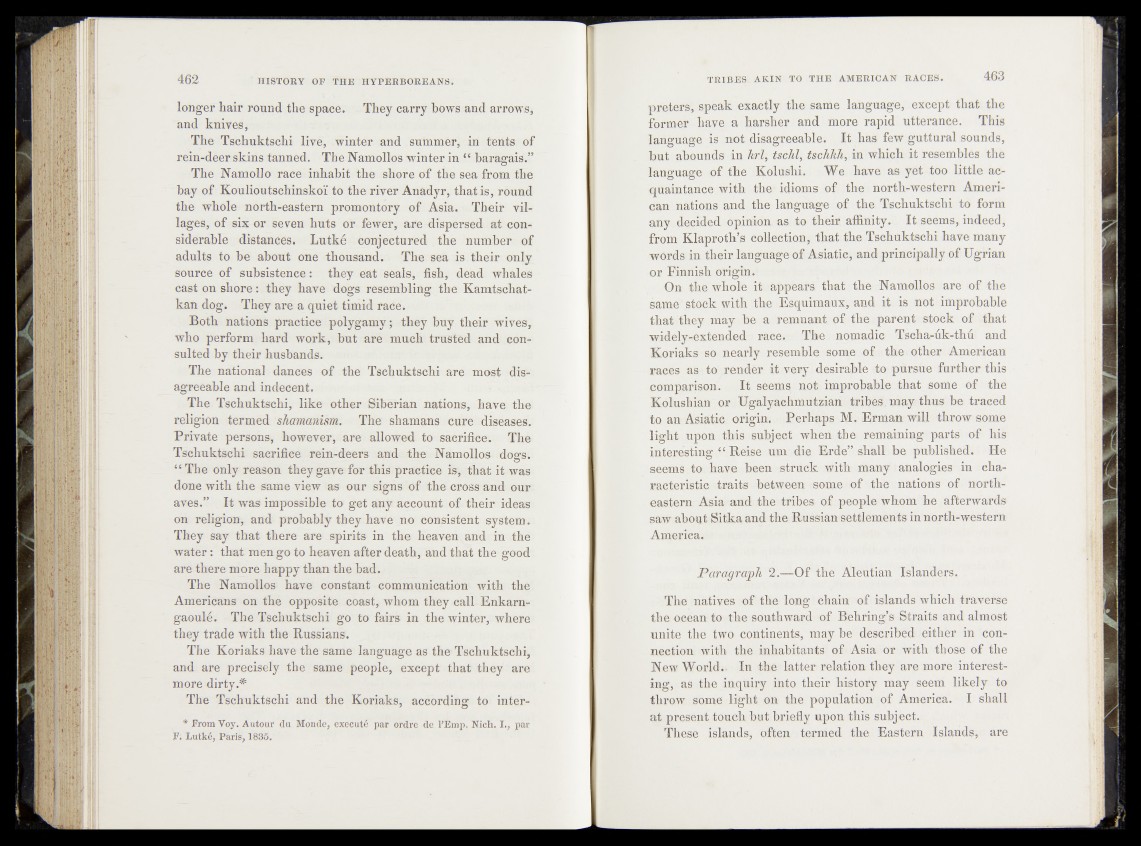
longer hair round the space. They carry hows and arrows*
and knives,
The Tschuktschi live, winter and summer, in tents of
rein-deer skins tanned. The Namollos winter in “ baragais.”
The Namollo race inhabit the shore of the sea from the
bay of Koulioutsehinskoï to the river Anadyr, that is, round
the whole north-eastern promontory of Asia. Their villages,
of six or seven huts or fewer, are dispersed at considerable
distances. Lutké conjectured the number of
adults to be about one thousand. The sea is their only
source of subsistence : they eat seals, fish, dead whales
cast on shore : they have dogs resembling the Kamtschat-
kan dog. They are a quiet timid race.
Both nations practice polygamy j they buy their wives,
who perform hard work, but are much trusted and consulted
by their husbands.
The national dances of the Tschuktschi are most dis?-
agreeable and indecent.
The Tschuktschi, like other Siberian nations, have: the
religion termed shamanism. The shamans cure-diseases.
Private persons, however, are allowed to^ sacrifiëiV Thé
Tschuktschi sacrifice rein-deers and the Namollos dogs.
“ The only reason they gave for this practice is?, that it was
done with the same view as our signs of the cross and our
aves.” It was impossible to get any account of their ideas
on religion, and probably they have no consistent system.
They say that there are spirits in the heaven and in the
water : that men go to heaven after death, and that the good
are there more happy than the bad.
The Namollos have constant communication with the
Americans on the opposite coast, whom they call Enkarn-
gaoulé. The Tschuktschi go to fairs in the winter, where
they trade with the Russians.
The Koriaks have the same language as the* Tschuktschi,
and are precisely the same people, except that they are
more <dirty
The Tschuktschi and the Koriaks, according to inter-
* From Voy. Autour du Monde, exécuté par ordre de 1’Emp. Nich, I., par
F; Lutké, Paris, 1835.
prefers, speak exactly the same language, except that the
loifme^- have a harsher and more rapid utterance. This
language is not disagreeable; It baa few guttural sounds,
but abounds in krl, tschl, tschkh, in which it resembles the
language of the Kolushi. We have, aa yet too little acquaintance
witk ifhe? idioms of the,;'north-western American
nations and. the language of the Tschuktschi to form
any decided opinion, as to their, affinity;.. It seems, indeed,
from Klaproth’s collection, that the Tschuktschi have many
words in their language of Asiatic^ andprincipally of Ugrian
or, Finnjskorigm.
On the whole it appears that the, Namollos are of the
same5.stock with the Esquimaux, andd-t-da not improbable
that they may . be a remnant, of the parent stock of that
widely-.exten.ded. race. The nomadic: Tscha-ukrthul and
Koriaks so nearly resemble, some of r the I other American
races as ‘ to/render it very desirable .to pursue further this
comparison. It seems, not improbable that some ©f ■ the
Kolushian or Hgalyachmut?mn tribes, may thus he traced
to an Asiatic origin. Perhaps M. Erman will throw some
light upon this subject when, the: remaining! parts ef- his
interesting “ Reise uni die. Erde” shall be published. He
seems ; to have been struck with many « analogies in characteristic
traits between isome;of the nations ofvnortheastern:
Asia and the tribes, of people whom he afterwards
Saw about Sitka and the Russian settlements in north-western
America. :
Paragraph 2.—Of the Aleutian Islanders.’
The natives of the long chain of islands which traverse
the ocean to the southward of Behring’^Straits and almost
unite the two continents, may he* described either in connection
with the inhabitants of* Asia-or with those7 of the
New W o r l d I n the latter relation they are moretifitefest-
ing, as the jnquiry into their history may seem likely to
throw some light on the population of America. I shall
at present touch but briefly upon this subject.
These islands, often termed the Eastern Islands, are